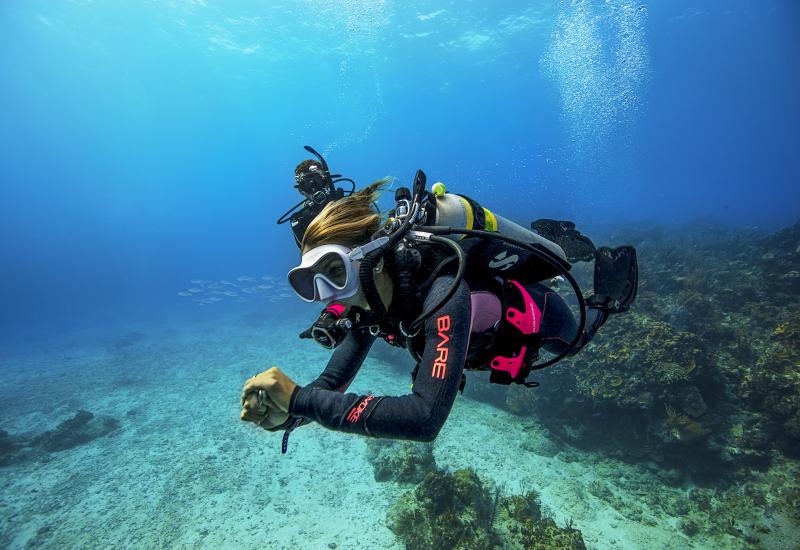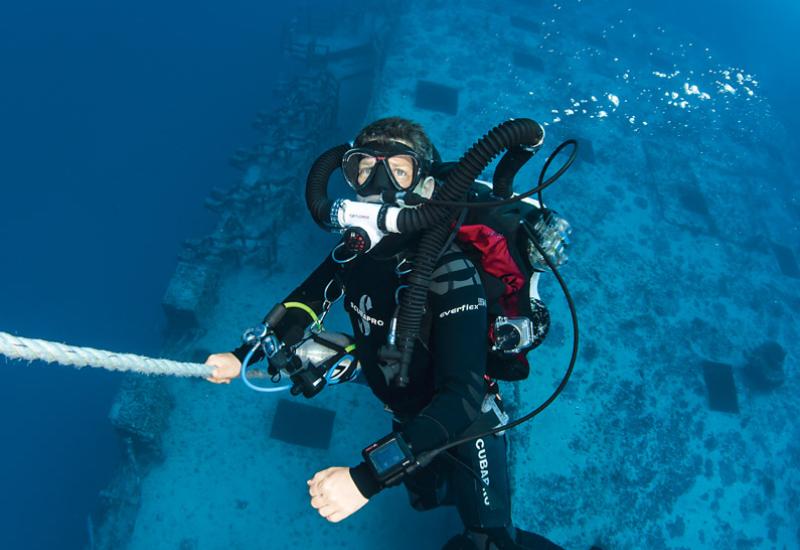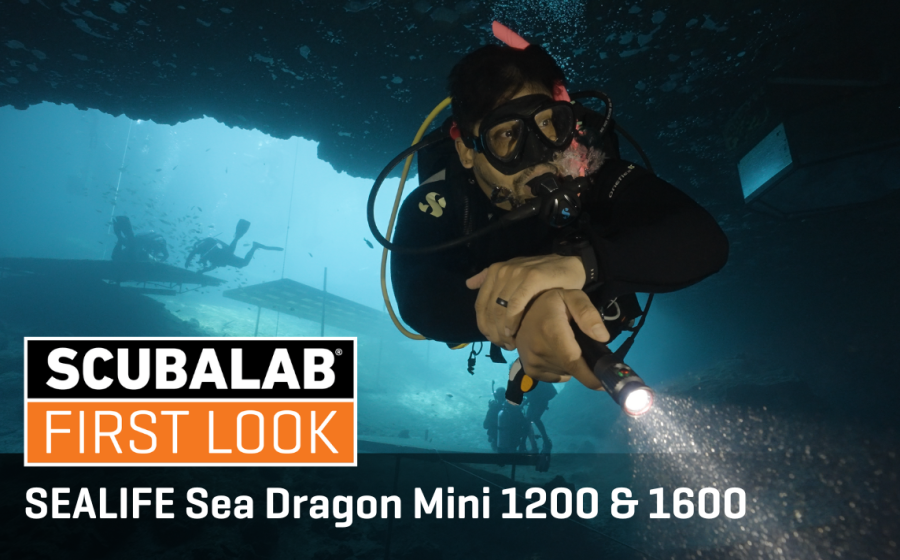Altered States: Five Very Different Scuba Diving Experiences

Polina ReznikovDouble-hose divers swim back in time at Portage Quarry in Bowling Green, Ohio.
Every adventure has defining moments — exhilarating events that become your most accessible memories, those that float to the surface of your mind when you're asked about your most unique dives. These five stand out for me.
Vintage Double-Hose Diving
Portage Quarry, Bowling Green, Ohio
Many divers got their first inspiration watching Sea Hunt on a black-and-white TV while sitting on the couch with a mask on their face and a snorkel in their mouth. They dreamed of becoming just like their featured hero, Mike Nelson. Played by Lloyd Bridges, Mike enthralled audiences with his underwater cops-and-robbers escapades. He would plunge into the ocean wearing the latest in scuba-diving technology — a double-hose regulator.
Those days are not a thing of the past. Vintage double-hose enthusiasts, young and old, enjoy a thriving community whose members dive well-maintained equipment on a regular basis and are eager to share the experience.
My first opportunity to dive a double-hose came on a 50th anniversary commemoration of the Sea Hunt series. After diving a rebreather the whole weekend, it was quite a change to put on such minimalist gear. To my surprise — considering I had no BCD — with regulated breathing, my buoyancy remained constant regardless of my depth. My exhaled breath was unobtrusivley vented toward the back. I truly felt one with my environment. This experience can be summarized in one word: liberating.
When to go: Every August, double-hose divers gather at Portage Quarry, Bowling Green, Ohio, for the Legends of Diving Festival.
How to get started: Create an account on Vintage Double Hose; peruse the posts, where you're sure to find excellent resources and connect with a different breed of divers.

Polina ReznikovThe author tried vintage military gear of Russian design.
Diving in Vintage Military Gear
Beach Haven, New Jersey
When an opportunity arose to dive vintage military equipment, my ears perked up. A number of pieces were being removed from displays at the New Jersey Maritime Museum for maintenance. The items of most interest to me were the submarine escape suit and two frogman diving suits, all Russian navy surplus. Along with other adventurous souls, I jumped at the chance to try them in a controlled environment.
These suits were not for claustrophobics. The one-piece bright-orange submarine escape suit has an incorporated full-face mask that is oral-nasal (with a nose pocket and a mouth opening for the on-demand regulator), and an exhaust valve on the top of the head. Breathing through the oral opening is key in not fogging up the separate eye windows, though this would be the least of the escapee's concerns in a real situation. The suit is set to deploy buoyant, to carry the escapee to the surface, and was typically used with a rebreather. For our exercise, we had to improvise and attach a back-mounted air cylinder.
The dark-green Russian frogman suits were also not made for comfort. One suit featured a single viewing plate with a window-wiper operated by a lever in the hood. The second suit was a two-piece secured by a hula-hoop-type ring, around which a heavy rubber band was stretched. None of the suits is realistically suitable for diving by today's standards, but they sure were fun to try — in the presence of safety divers.
Reference: Fred Barthes ([email protected]) exhibits his extensive vintage military and hard-hat gear at the New Jersey Maritime Museum (museumofnjmh.org). This experience is not available to the general public; however, the museum welcomes visitors to its Beach Haven, New Jersey, location.

Polina ReznikovWeighted for salt, a diver can suddenly be sinking in an iceberg's fresh runoff.
Iceberg Diving
St. John's, Newfoundland, Canada
As if getting into 35 degree F water weren't exciting enough, looking up at the imposing iceberg I'm about to explore certainly spikes my heart rate.
I slip into the frigid water and start my approach to the cerulean berg. Breaking through the halocline wall, I drop unexpectedly. The halocline is the common space where the iceberg's melt dances with the salty ocean — weighted for the ocean, I am now in the iceberg's freshwater realm. I adjust my buoyancy but am still swaying and bouncing.
As this ungrounded iceberg bobs up and down, it creates an undertow, moving with it whatever is in its grip — in this case, me. Adding to my disorientation is a cacophony of creaks, groans and bangs caused as the cracks in the melting iceberg contract and expand. In spellbound awe, I get closer, running my hand across exquisite, crevassed ice accented by pockmarks and deep grooves running vertically in streaks of radiant blue.
The berg is fizzing like champagne as air bubbles trapped within its gut for thousands of years escape. I caress the luminous sculptured body with care. As the iceberg melts, its constantly evolving irregularities shift its center of gravity, eventually causing it to roll over to a new, more stable position. (Icebergs have been known to be treacherous obstacles for ill-prepared ships — Titanic met its resting place in these waters in April 1912.)
Between 400 and 800 bergs make an annual journey from Greenland's Baffin Bay along Iceberg Alley, making a detour around St. John, the most accessible iceberg theater in the world.
When to go: Mid-spring to early summer.
Operator: Ocean Quest Adventures in Conception Bay South, Newfoundland, is a five-star National Geographic Resort. Owner Rick Stanley expertly identifies divable icebergs, and also offers wreck diving, whale snorkeling and the Bell Island Submarine Mine Tour.
Price Tag: Pricing varies whether for a group or individual; call 866-623-2664 for details.

Polina ReznikovThe 150-pound load is worth it for the sensation of walking on the moon.
Black-Water Diving
Cooper River, South Carolina
Why would diving solo in a 3-knot black river inhabited by alligators sound appealing? The possibility of finding my own megalodon teeth and native Indian artifacts are driving my madness.
Chances are, Cooper River is not on your bucket list. A typical dive starts as an overweighted free-fall into swift waters without the aid of a down line. Ambient light trickles in until about 10 feet. I know I've landed when my face plants on the bottom — my cue to ram my modified screwdriver into the gravel and hold on. As the current drags me, I dig in the edges of my fins, come to a rest and gather my wits. My regulator is vibrating in my mouth and threatens to rip out of my clenched teeth. I avoid tuning my head sideways to the current and try to remember if I donned the mask before the hood. My 21-watt torch illuminates no more than a foot out; the only indication of a diver nearby is the faint sound of exhaled breath.
I get situated and start to rummage through the rubble, wondering briefly where the nearest alligator is. Oh, wait, is that what I think it is? I feel the serrations of its rim. I examine it further and scream into my regulator, "I've got one!"
I continue to forage for some 30 more minutes but am quickly tiring from holding onto the screwdriver in the wicked current. I secure my goodie bag and unclip the SMB. Hooking my bent elbow around the screwdriver, I quickly free up my other hand, dig my knees and fins into the gravel, and press the nozzle on the spare air hose into the SMB's intake valve. (If you don't want to be spat out into the Atlantic Ocean or mauled by boat traffic, a safety stop is strongly discouraged.) Besides, trying to read the gauges is futile.
Back on the boat, I inspect my booty — lots of broken and some intact pieces of megalodon teeth, a fossilized whale vertebra, a chipped Native American arrowhead and some old bottles. Now that's well worth the intense dive.
When to go: Summer months when temperatures range from 70 to 85 degrees F.
Operator: Contact Bill Routh of Lake Jocassee Dive Shop in Salem, South Carolina. Routh, who has been diving here since 1984, runs the river in a 32-foot covered pontoon boat.
Price tag: Contact for details.

Polina ReznikovWell-mainted vintage gear finds new life in the hands of enthusiasts.
Hard-Hat Diving
Dutch Springs, Pennsylvania
Short of putting yourself through a commercial-diving school, there aren't many places to experience diving in hard-hat gear. But if you're in decent physical condition and are able to carry at least 150 pounds into the water, this dive will reward you with a feeling akin to walking on the moon.
After being artfully dressed by many hands and conducting a very detailed dry practice dive, I was ready to stride in. Walking on the bottom, I regulate the air flowing into my suit with the gas-flow valve in my hand. Let in more air, and I'm almost weightless. I was essentially diving inside my own BCD while breathing the same air, refreshed by pushing the side of my head onto an air-release valve on the inside of the helmet. To do this dive, you should be comfortable clearing your ears by shifting your jaw sideways to stretch your Eustachian tubes, or by a swallowing motion. Attached to me was an umbilical consisting of the air-supply line, a safety line and a communication line (through which I repeatedly uttered, "Wow, this is cool!"). There was always at least one safety diver alongside me, and I was typically in depths shallower than 25 feet. The most difficult part was walking to and from the water in the suit. But if you ever wanted to know what a spacewalk is like, this is as close as you can get.
When to go: Over Memorial Day and Labor Day weekends at Dutch Springs, Pennsylvania.
Operator: North East Dive Equipment Group (NEDEG) consists of individuals with privately owned gear, which they make available at rallies on a volunteer basis. Email [email protected] for information.
Price Tag: NEDEG does not charge a fee but welcomes a tip for giving you this unique experience.

Polina ReznikovDouble-hose divers swim back in time at Portage Quarry in Bowling Green, Ohio.










